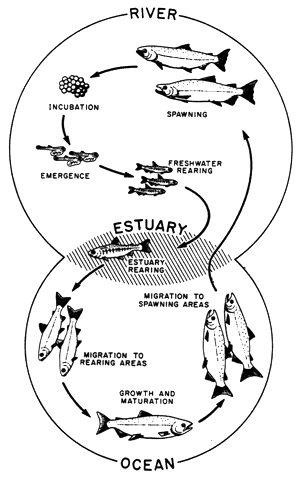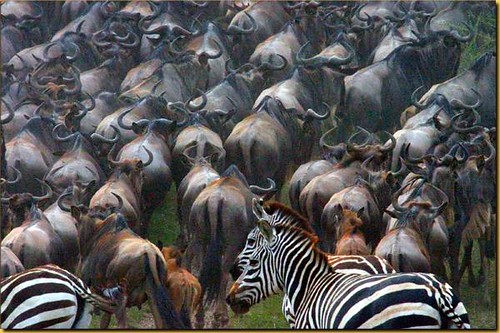tags: researchblogging.org, animal migration, ecology, conservation, habitat destruction, global warming, overexploitation
Image: Makoa Farm Horseback Riding Safaris in Tanzania [larger view].
What do salmon, passenger pigeons, American bison and wildebeest have in common? They all are (or were) migratory, and their populations either are declining or have become extinct. In fact, the populations of nearly all migratory animals, from insects to fishes, birds to mammals, are suffering disproportionate population declines that sedentary species are not experiencing. This is hardly surprising since these animals travel from one location to another, something that requires a lot of energy and exposes them to dangers they might otherwise avoid. But considering all the other ecological and environmental problems facing this planet, should we even care if the great animal migrations cease? Why?
"Protecting the abundance of migrants is the key to protecting the ecological importance of migration," write the authors, Princeton University evolutionary ecologists, David S. Wilcove and Martin Wikelski -- a colleague of mine from the University of Washington where we worked in the same lab.
"As the number of migrants declines, so too do many of the most important ecological properties and services associated with them," they argue.
 Just what ecological roles do migrants fulfill and what services do they provide? Let's look at a familiar North American migratory animal: the salmonids of the Pacific Northwest. There are seven species of migratory salmon and trout in the Pacific Northwest, and they all share a common life history (pictured, right): they leave their natal freshwater rivers as smolts and migrate to the ocean where they live and mature for several years. Then they migrate en masse to their natal rivers where they spawn and die. By returning, they transfer precious nutrients inland from the sea in the form of feces, young fishes, and decaying bodies. These essential nutrients, particularly phosphorus and nitrogen, both of which are limited, sustain bacteria, phytoplankton, zooplankton and other life forms that are the very foundation of this ecosystem.
Just what ecological roles do migrants fulfill and what services do they provide? Let's look at a familiar North American migratory animal: the salmonids of the Pacific Northwest. There are seven species of migratory salmon and trout in the Pacific Northwest, and they all share a common life history (pictured, right): they leave their natal freshwater rivers as smolts and migrate to the ocean where they live and mature for several years. Then they migrate en masse to their natal rivers where they spawn and die. By returning, they transfer precious nutrients inland from the sea in the form of feces, young fishes, and decaying bodies. These essential nutrients, particularly phosphorus and nitrogen, both of which are limited, sustain bacteria, phytoplankton, zooplankton and other life forms that are the very foundation of this ecosystem.
But humans have dramatically affected salmonids: before Europeans became established in North America, there were between 160-226 million kilograms of salmon migrating up the rivers of Washington, Idaho, Oregon and California, whereas today, this migration has dwindled to only 12-14 million kilograms. It doesn't take a rocket scientist to recognize that this represents a drastic decrease in the total nitrogen and phosphorus deposited in the river ecosystems and the surrounding lands of the Pacific Northwest to only six or seven percent of what these salmon once delivered.
But it isn't just fish whose numbers are steeply declining. Similar population declines are occurring among neotropical migratory songbirds, whose total biomass currently is estimated at only 30,000 tons (which translates into 3,000-10,500 tons of insects consumed per day -- before they begin rearing their chicks). What would happen if they disappeared? Similarly, what would happen to the ecology of Africa if the wildebeest migration, currently one million strong, ended? Such events would undoubtedly trigger dramatic and far-reaching effects, although we have no clear idea of what those effects might be.
What is causing these population declines in migratory animals? The authors note that humans are the source of these diminishing population, but there is no one particular disturbance that orchestrates all these declines, that the reasons for these population declines vary from species to species and site to site, which complicates the issue. For example, migratory songbirds, a research animal that has inspired the publication of thousands of papers, suffer from a combination of factors that contribute to their mortality: loss of breeding habitat; loss of wintering habitat; loss of precious refueling sites; increased mortality due to pesticide poisoning, predation by domestic cats, collisions with windows, communication towers and windmills, indiscriminate hunting by humans, and other factors -- and from a combination of these factors. But most migratory birds and animals remain poorly known in comparison to a few songbird species, while other animals, such as bats, although ecologically important, remain a complete enigma.
So what should we do? Unfortunately, even though the authors recognize the ecological value of large migrations of animals, they do not -- indeed, cannot -- provide specific remedies to the problem of how to safeguard them since, "[g]iven the gaps in our knowledge of the migratory patterns and demographic connectivity" for the majority of these animals, the best strategy remains a shotgun approach: "protect as much habitat in as many places as possible and hope for the best. Such is the state of play for most migratory birds, bats, and insects."
Um, hope for the best??
Call me a pessimist, but that's just silly. Humans lack the political will and the intellectual honesty and integrity necessary to make a concerted effort to protect anything beyond those few creatures that we can propagate in captivity for our own purposes. In fact, the only thing that humans are capable of doing with any efficiency is reproducing themselves into ever increasing numbers. For example, even though salmon are economically valuable, several salmon runs in the Pacific Northwest are classified as endangered and more are ready to follow, yet despite governmental protections, these salmon runs are still decreasing due to the combined threats of dams and water overuse, logging, farming, pesticide and fertilizer pollution, untreated sewage, overfishing and from "the elephant in the living room": plain old human overpopulation.
Further, humans have proven time and again that they are completely incapable of conserving anything as demanding as animals that move freely across vast distances and geopolitical and cultural boundaries, regardless of the consequences associated with their extinction. I predict that, one hundred years from now, most migratory animals will have completely disappeared, just like the seemingly endless flocks of passenger pigeons that once darkened the skies of eastern North America, only to be replaced with vast monocultures of exotic, highly inbreed or genetically modified animals and plants.
Of course, at least some insects (along with the familiar exotic Norwegian and black rats and house mice) will thrive in huge numbers in such an impoverished and barren environment. Instead, I grieve every day for yesterday's world and its truly vast and awe-inspiring animal migrations.
Sources
Wilcove, D.S., Wikelski, M. (2008). Going, Going, Gone: Is Animal Migration Disappearing? PLoS Biology, 6(7), e188. DOI: 10.1371/journal.pbio.0060188
Berger, J., Young, J.K., Berger, K.M. (2008). Protecting Migration Corridors: Challenges and Optimism for Mongolian Saiga. PLoS Biology, 6(7), e165. DOI: 10.1371/journal.pbio.0060165
- Log in to post comments


Rat meat: the food of the future.
Rat: the other white meat.
You forgot about amoeba migrations! All these other critters are just following the example set by the great seasonal amoebic migrations. And amoebas never really die, they just conglomerate. Something like that anyway.
migrating down the food chain?
WOW! Well said article!
"The elephant in the room, plain old human overpopulation."
You got that right.
Formula for ecological catastrophe caused by human overpopulation:
1. make contraception and all abortions illegal
2. ban sex education
3. make sex a "sin"
4. teach your kids to value stupidity by having them idolize people who brag about stuff like "I was 894th out of 899 in my graduating class" or "Look at me, I'm a C-student, and now I'm Preznit. Nyuk, nyuk, nyuk!"
Then send your stupid, uneducated kids who know nothing about sex out into the world and say to them "don't have sex, OK?"
Result: 10 billion people by 2100.
Take that, you migrating monarchs!